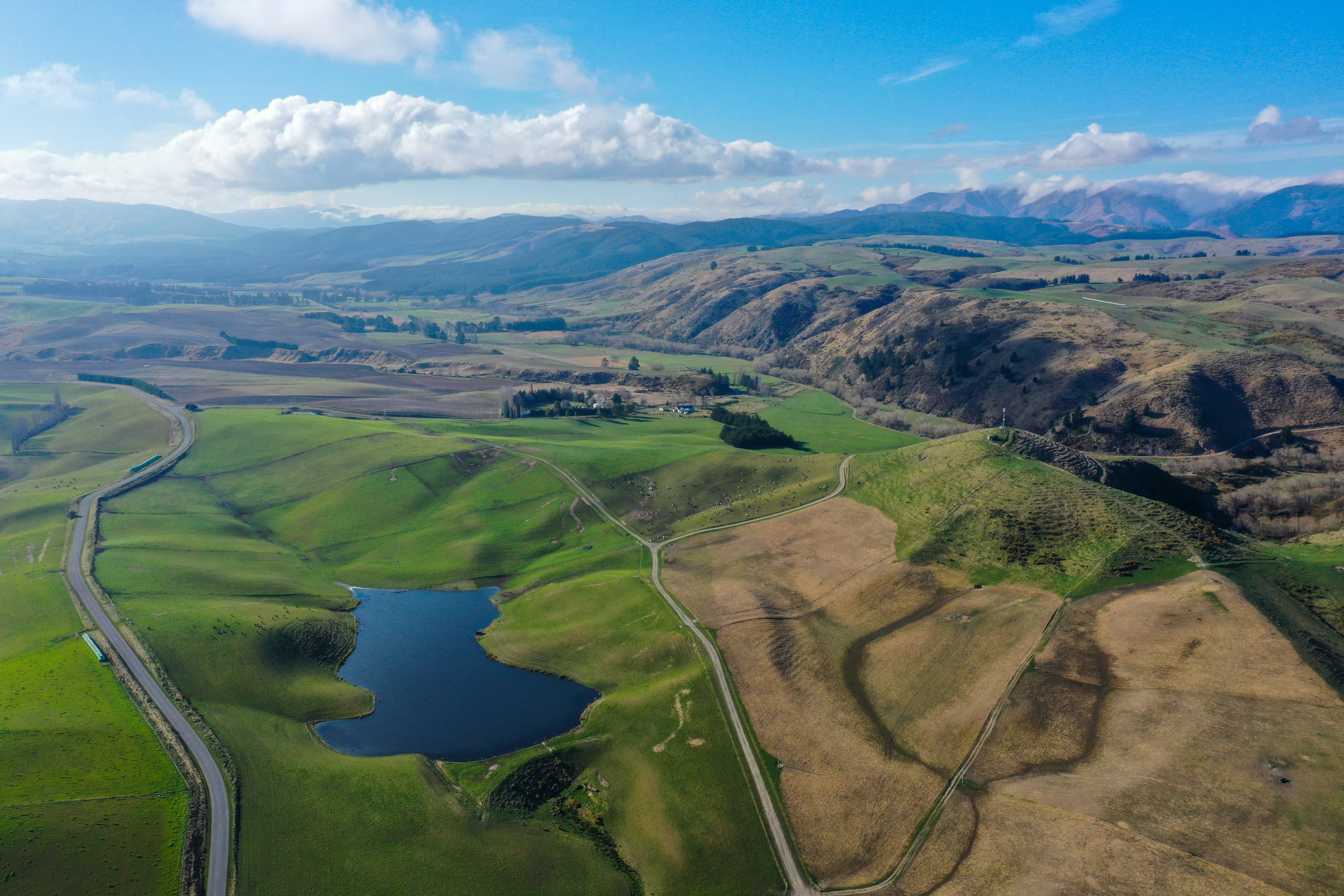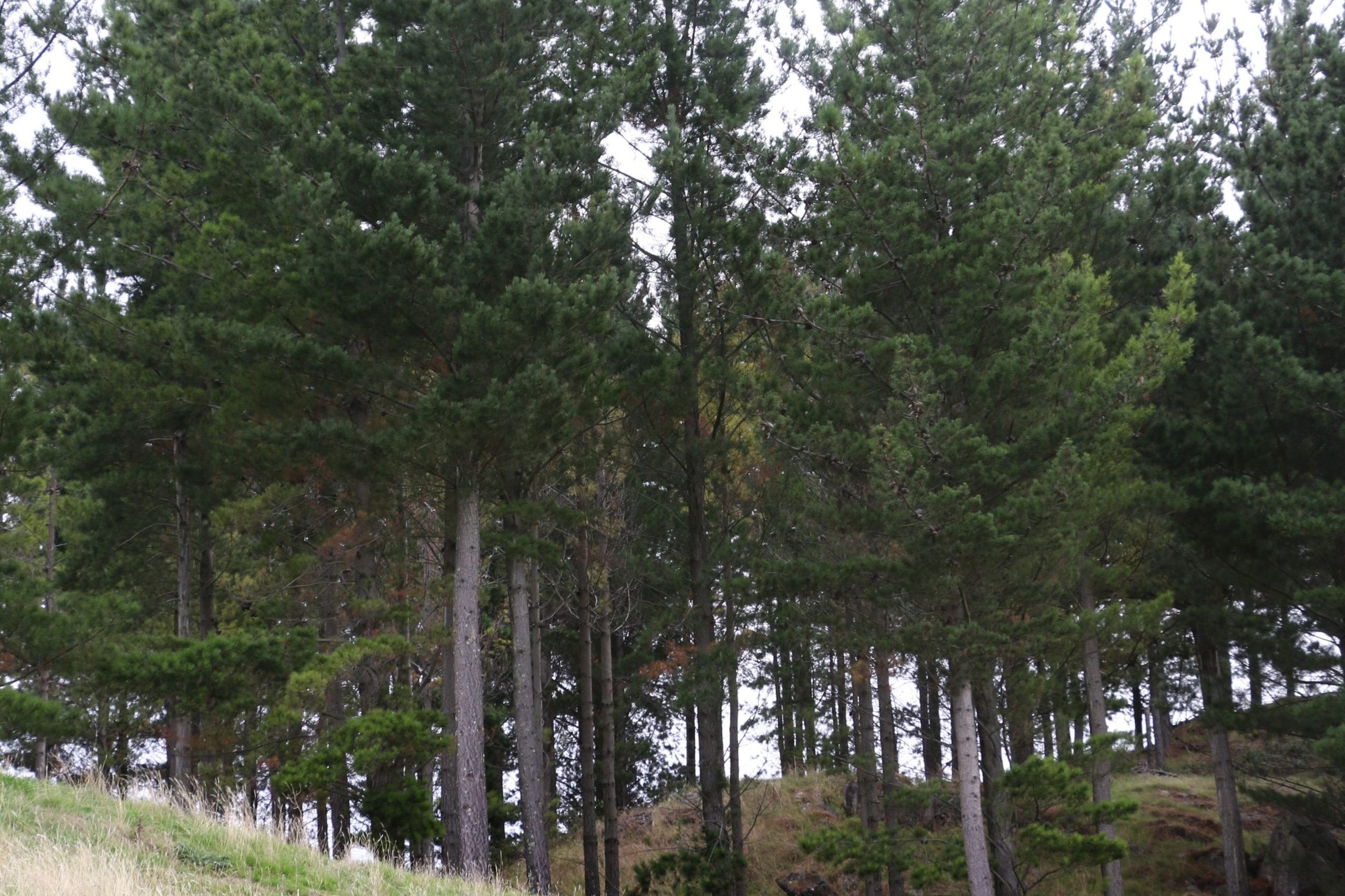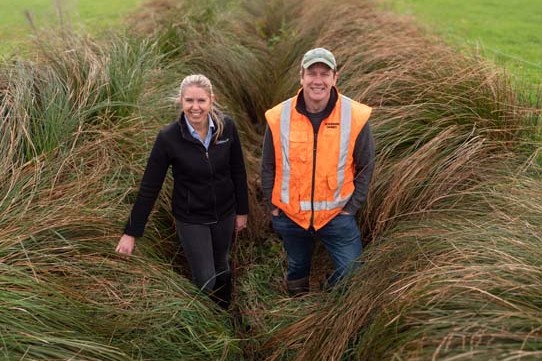Careful establishment, fertilising, and grazing of crops along with controlled water use helped a Central Otago couple win the Ballance Farm Environment Supreme Award for Otago.
It’s three in the afternoon near the end of May at Omakau in Central Otago, and Anna and Ben Gillespie are outside discussing the temperature.
Anna says according to her phone it’s 0.5C. Ben says the dash of his ute is telling him it’s 1C.
Not that it matters. The Kiwicross dairy 720 R1s and 700 R2s on the dry stock farm are warm with their bellies full of fodder beet in the thick mist.
The couple were announced as the Otago Ballance Farm Environment supreme winners in April and also won the Ballance Agri-Nutrients Soil Management Award and the WaterForce Wise with Water Award.
And it’s their wintering of the dairy cattle that stood out for the judges. Not only is there minimal impact to their soils and nearby waterways but the dairy stock they graze are fully fed and up to weight.
“We body condition scored them in April this year and the R2s were at 5.5 and were 450kg,” Anna said.
“Last year we did it in May and they were at 5.8 so we had to be a bit careful not to put on any more condition over winter.”
The young dairy cattle are from two Southland farms – one at Riverton and the other Otahuti – and come to Anna and Ben’s at weaning.
They stay for two winters and go home ready to calve.
The dairy grazing brings in monthly cashflow and they buy store beef cattle in the autumn and spring, depending on the season’s growth, aiming to send them to the works six months later.
“If the beef side wasn’t so variable we would have more beef cattle but the prices fluctuate too much,” Ben said.
As well, they enjoy working with the dairy stock.
“We love making them into pets, which is probably not so good for when they go home,” Ben said.
Having the R1s arrive on the farm in December helps with wintering.
“When they arrive we put them behind wires so at the end of April when they go onto the beet they’re used to the farm, used to the fences, and they’re really settled,” Anna said.
In 2011 they first farmed the property, which belonged to Ben’s parents, wintering dairy cows.
“They were long winters, very intensive, seven days a week. The young stock are now so much easier.”
Heifers are mated to AI on a five-day synchro and then the bulls go out.
“As they are two different lines this means we do one mob, finish their programme, and then start the next so we aren’t literally drafting 700 heifers a day.”
The couple met at Lincoln University and both have masters degrees in agriculture. They worked on the Landcorp Wairakei Estate at Taupo for several years before moving south again to take over the family farm lease, and in 2017 bought the farm.
This summer they grew 42ha of Brigadier fodder beet under irrigation (the area’s rainfall is 450mm per annum) and estimate the crop to be about 25t.
“We don’t measure it. It’s about the only thing we don’t measure. We measure the grass weekly during the summer and everything else, but the beet lasts as long as it lasts and that’s it,” Anna said.
The only date they have to work to is when the R2s leave the property in July and all the other stock are flexible.
At the end of April the cattle are transitioned on to the beet with the fences moving centimetres at first. Grass areas in the paddock that haven’t been planted help with the transitioning.
When everything is fine they are ad-lib fed along with lucerne hay made onfarm and, for the R1s, grass because of the extra protein.
They use hot standards to stop breakouts and ride the fence lines every afternoon to check them.
“Sometimes there will be a leaf hanging over a wire or a bulb up against a standard shorting out the fence. It just pays to check,” Anna said.
The don’t use portable water troughs as any pipes above ground freeze, but make sure there are two troughs, one at each end, of every 5½ha crop paddock.
Anna, who does all the stock work, carries a garden fork with her on the quad bike to break the ice in the troughs every morning.
“They don’t drink a lot of water. If they’re eating 10kg DM of fodder beet a day then that’s a 100 litres of water they’re getting from the beet if they’re 10% dry matter,” Ben said.
While Anna is shifting about 15 fences a day, Ben does the tractor work filling the feeders with lucerne hay.
Fodder beet guru Jim Gibbs, Lincoln University’s senior lecturer in livestock health and production, is a regular visitor to the farm looking over their feeding of fodder beet as well as bringing overseas visitors such as seed reps and agronomists.
There are two main soil types on the farm and Anna and Ben no longer grow beet on their heavy clays.
“It wouldn’t get really muddy, not what other people call muddy, but it was hard work shifting fences with the clay sticking to your gumboots. By the end of walking a fence line there was so much it was hard to walk,” Anna said.
“Overseer was also showing it was a hotspot from nitrogen losses.
“Now we just crop the gravel silt loams at the top of the farm and it’s a lot better.”
The stony ground stays hard through winter so the cattle are happier and it’s easier for Anna to walk around on, although getting fencing standards into the ground can be trying.
They back fence to keep the mobs together so they can keep an eye on them, especially when calving looms for the R2s.
The rotation is two years in beet and then back into grass. The crop paddocks are always under one of the farm’s two pivots, which cover 145ha and 42ha, or the hard hose guns, which cover another 50ha.
Their water take is through the Omakau Irrigation Company.
The fodder beet costs them about $2000/ha to grow although they don’t add up every cent.
They soil test every beet paddock prior to sowing and are aiming to raise the pH from 5.8 to 6.2 and get the Olsen Ps into the mid-20s.
At sowing, 200kg Crop16N, 100kg ag salt, and 30kg boron per hectare is spread, and when the cotyledons are showing (the first leaves before the true leaves) 200kg sulphate of ammonia goes on as well.
They use ag salt because it’s more cost effective than using potassium, which fodder beet has a high demand for. The plant is able to substitute the Na+ ion from salt (NaCl) for the K+ ion it would otherwise find in the soil.
After that there are two applications of Sustain N at 100kg/ha, each flown on through the season.
“We’re really trying to keep the plant growing right through the summer. We want green leaves at winter grazing for the young stock to eat,” Ben said.
“A lot of the agronomy of fodder beet is still from the UK and Europe where they don’t want leaves because it’s all lifted.
“And with sugar beet they don’t want any nitrogen content in the bulbs because it’s getting made into sugar, but we do, so that’s why the extra nitrogen.”
It’s the second time they’ve entered the Ballance Awards after failing to get through to the finals several years ago.
“It’s just really good having another set of eyes looking at what you’re doing.”
Children Will (9) and Milly (7) enjoy getting out on the farm and help shifting fences. They also own their own beef cattle and go with Anna to sales to buy their own stock.
There are no rivers, streams, creeks, or even flowing ditches on the farm although in the gullies there are several springs, some of which dry up in the summer.
Ben and Anna pot up the native seedlings they find in the garden and use others for cuttings and plant them out in the farm’s riparian areas when they’re big enough.
“With both our parents farmers who were of the mindset to plant trees, we’ve grown up with it so it’s just what we do,” Anna said.
She’s chair of the Manuherikia Catchment Group and they’re both on the Lauder water users’ group as well as school and other committees. Anna is also on the executive of the Federated Farmers Otago branch.
“When lockdown happened we wiped our diaries clear,” Ben said.
- Ben and Anna Gillespie are one of four New Zealand farmers who have been selected as finalists of the inaugural Zimmatic™ Sustainable Irrigation Awards which aim to celebrate excellence in sustainable irrigation and encourage Australian and New Zealand farmers to share ideas for achieving sustainable freshwater management. On-farm judging will take place in the Spring before the supreme winner is announced.






